Types of Bathroom Tiles (12 Stylish Options)
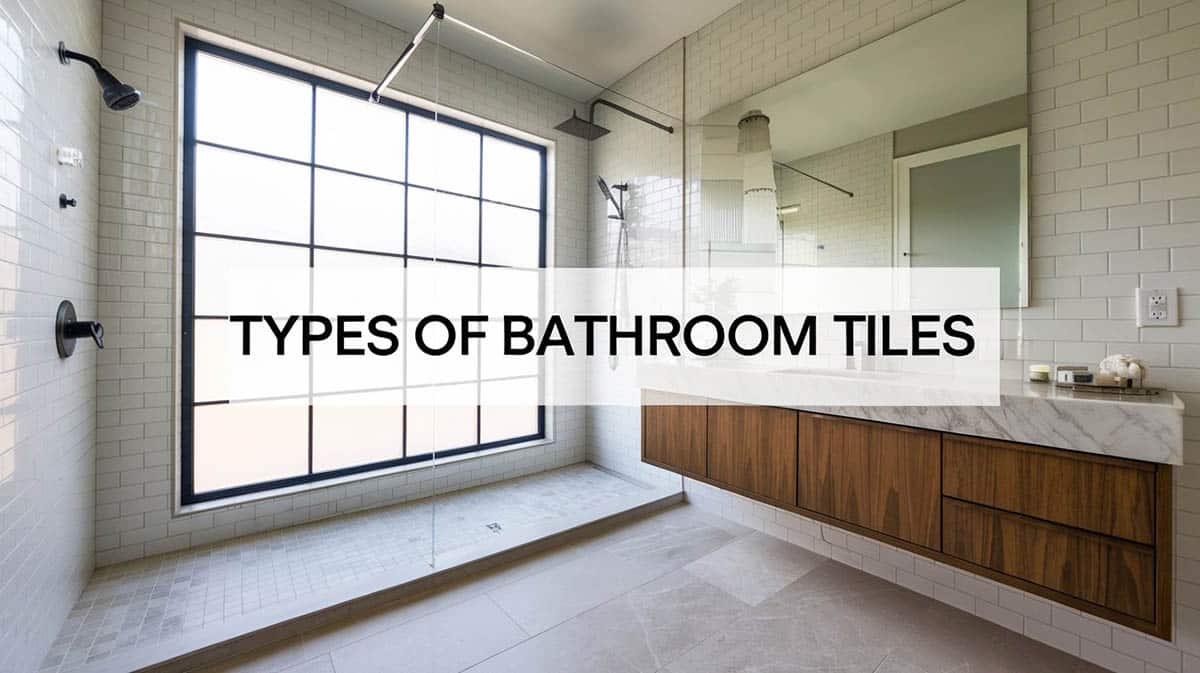
Many people frequent the bathrooms in your house, so you want to make sure they look good. The flooring and wall tiles you decide to use are a big part of the design of your bathroom. In this guide, we’ll share the types of bathroom tiles to help you choose the best material for your design. There are some extra considerations you must keep in mind – the main one being that the flooring and walls must handle water well. Below, we look at some options you have that will look great and withstand what a bathroom is put through.
Porcelain or Ceramic Tile
Let’s start off with a classic option for a bathroom floor: porcelain or ceramic tile. These choices are so popular because they are attractive and budget-friendly at around $1.09 per square foot. You can get these tiles in almost any shape or pattern that you can imagine. If you are looking to complete your new flooring as a DIY, there are versions that are sold in which you don’t have to lay down each tile individually. These are pre-mounted onto a plastic mesh sheet that can be simply laid down and sealed into place.
There is a slight difference between porcelain and ceramic in that porcelain is a type of ceramic that has a higher-than-average absorption rate. According to the Tile Council of North America, (TCNA) porcelain tiles have an absorption rate of 0.5% at most. This makes them a great choice for bathroom floors. For more pictures visit our gallery of bathroom floor tile ideas.
As we’ve mentioned, one of the biggest draws of porcelain and ceramic tiles is their versatility in design. Not only do they come in different tile shapes, but many homeowners also use details such as tinted grout to make their designs unique. Another great thing about ceramic and porcelain is that they’re easy to clean. Regular sweeping and mopping, along with occasional grout cleaning, will do the trick.
These materials have a few disadvantages. For one, they are rather slippery, especially when wet. Luckily, many homeowners circumvent this by using a bath mat or raised-texture floor tiles. Some also dislike that ceramic doesn’t retain heat, so it’s chilly when you walk into the bathroom in the middle of the night.
Vinyl Tile
Vinyl tile is another popular choice for bathrooms. This is, in large part, due to its practicality and attractiveness. There are a few types of vinyl flooring. It’s also affordable, at an estimated $0.95 per square foot. For one, there is sheet vinyl flooring. This is recommended if you expect a large amount of water on the floor. It lends itself to bathrooms, especially kids’ bathrooms.
Good quality vinyl flooring resists staining, scratches, gouges, and tearing. – Materials for Interior Environments, Corky Binggeli
One reason is that there aren’t many seams for water to seep into. Thanks to the large sheets they come in, some bathrooms may have no seams. On the other hand, there is luxury vinyl plank flooring. This is a flooring style; instead of coming in sheets, it comes in narrow planks. These are usually around 5 inches wide and up to 48 inches long.
This type of flooring is also very effective at handling water and comes in almost any style. So, you can find something that works for whatever decor style you use in your bathroom. While you can install vinyl flooring yourself, you need to be careful. Getting the seams tight is crucial. If the seams have gaps, the flooring will not be as resistant to water as you want.
Natural Stone Tile
Natural stone tile is a more expensive choice, but it’s also a beautiful one. Many different types of stone might be used in flooring, though, and to help you make the best choice, we need to take a closer look at some of your specific options. The most popular types of natural stone are marble, limestone/travertine, granite, and slate.
Marble Tile
Marble tile is well-known for its beauty. It comes in various patterns and hues, and it can seem like no two marble tile floors are the same. Some are even multi-colored. These aesthetic features make it easy to match marble to any color scheme. You can depend on marble to bring your bathroom a high-class look of regal elegance. Much like many other options we’ve looked at here, marble can be cut into different tile sizes and shapes.
Marble is becoming a popular choice and is even used in bathroom showers and for countertops, and floors. You will want to make sure that the marble is sealed properly to make sure that it lasts as long as it has the potential to. Marble is naturally porous meaning that it isn’t well-prepared for water on its own. You’ll also want to avoid using harsh chemicals on it when cleaning.
The biggest disadvantage of marble is that it is prone to cracking and scratching. Most recommend that homeowners buy extra tiles to make repairs as needed. You’ll also want to be careful because marble gets slick when wet.
Marble is a more expensive choice at around $10 to $20 per square foot. However, it is the cost for a more aesthetically luxurious finish. See more marble shower designs here.
Limestone & Travertine Tile
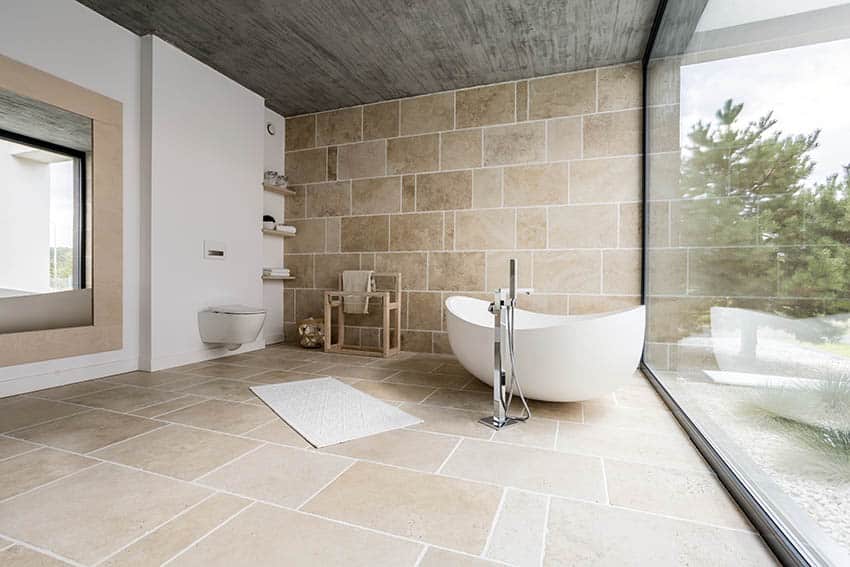
Limestone isn’t as colorful as stone options like marble. You will likely find lighter shades such as ivory and beige with limestone. This is a plus for many homeowners as it’s easy to match with any decor style. If you’re set on darker tones, though, you might be able to find red or brown shades as well. They are also used in many tile patterns to offer even more visual variety.
Much like porcelain is a type of ceramic, travertine is a type of limestone. It also comes in calmer colors ranging from off-whites to rust. On the topic of limestone appearances, this is another material that benefits from the natural stone appearance of each stone used, which has a different natural formation.
Any type of limestone can be relied on to last a long time without showing much wear and tear. Even if something were to chip or crack, the tiles would be easy to remove and replace. To ensure that limestone lasts in your bathroom, it needs to be properly sealed and kept that way. Specifically, limestone needs a dual-sealing treatment.
Frequent resealing will give your flooring a glossy look. Since the tiles are so heavy, you’ll probably want to leave the installation to the professionals. Like most natural stones, limestone is also expensive. See this page for travertine shower ideas.
Granite Tile
Granite is a common material for countertops, and it’s also a natural stone that can be a beautiful choice for bathroom floors. One of the biggest reasons granite has is its incredible durability. Unlike the natural stones we’ve looked at so far, granite isn’t quite as porous. Its ability to withstand frequent moisture makes it a good fit for bathrooms. It also isn’t going to easily scratch or chip, so you’ll be able to rely on it for a long time.
When it comes to appearances, granite is versatile. It comes in a range of colors and patterns thanks to variants in the formation of granite. The standard colors in granite range from white to black to beiges, browns, and even blues and reds. Multicolored and patterned designs are common as well.
Granite tiles are rather heavy, so you’ll want to make sure that your floor can support them. For example, a square foot of .75-inch deep granite flooring weighs almost 13 pounds. This weight can be harder to manage in older homes, so it’s a good idea to consult professional help for this installation.
A final, long-term benefit of granite flooring is that it can elevate the property value of your home. This is because you’ve installed something attractive that will last a lifetime.
Slate Tile
Slate is one of the strongest options when choosing a style of natural stone flooring. It’s naturally resistant to cracking, scratching, chipping, or breaking. It will stain if left alone, but most installations include sealing the floor against stains. This type of flooring does need to be resealed regularly to keep it safe from staining.
This material also has the benefits of other natural stones in that it comes in a lot of different styles. Due to natural formations, each piece of slate has a one-of-a-kind look, giving your bathroom a little personality.
Slate flooring is a rather expensive option. After all, it lasts a long time, and it’s considered a rather valuable choice. What can make up for the hefty initial purchase and installation is the value this design choice adds to your home’s property value.
The balance of cleft finishes needs to be addressed for bathroom floors. Cleft finishes are rough – these are rough and uneven. These are meant to help give the floor some traction and are often a finished used in wet environments.
The downfall of cleft finishes is that they aren’t very comfortable under bare feet. Most bathrooms don’t use cleft finishes, so this means you’ll want to be aware of a slippery surface when you get out of the shower. You’ll also want to consider the weight of slate just as you would for granite. It’s probably best to leave this installation to a trained professional.
Mosaic Tile
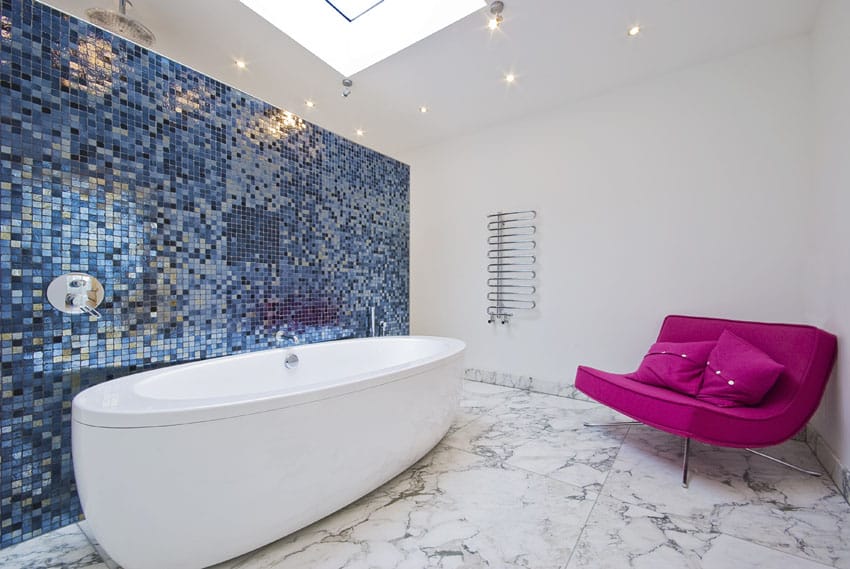
Mosaic tiles aren’t made of a single material. You could technically make mosaic tile flooring out of almost anything – glass, ceramics, or stone. What makes these stone mosaic tiles is that they are used in small pieces to create a larger design. This doesn’t need to be the traditional sense of an artistic picture. The design may just be – and usually is – meant to be a creative pattern. Mosaic tiles are also easy to clean and won’t get ruined by your standard cleaning chemicals.
Another great thing about mosaic flooring is that it’s a great way to use the material of your dreams at less of a price. Not to mention, the patterns created with these materials will be completely distinct, giving your home a personal touch.
There are two main drawbacks to mosaic tile. For one, they are smaller, broken-down versions of the material being used. This size makes them more susceptible to damage.
You’ll need to be careful when cracking and breaking – dropping large items on the floor may cause problems. Scratches are also a common worry with mosaic tile. Luckily, if a piece gets damaged, it’s rather simple to replace. Secondly, mosaic tiles don’t have a lot of traction. This means you’ll want to be sure to put a bath mat down to reduce slips and falls.
Glass Tile
A fashionable and unique way to make your bathroom stand out is to use glass tile on the floor. These can be stained in different colors and tones, and the tiles can be shaped to add extra one-of-a-kind touches to the design. Glass tiles are also recommended for adding depth to the design.
Ensuring you get a glass rated for use on floors is important. The glass in your windows isn’t the same glass that’s used for floors. This material is one of the more expensive options, ranging from $7 to $30 or more per square foot.
The biggest draw to glass tile is how gorgeous it is. It can also be manipulated in so many ways that you can find a style that fits almost any design you can dream up. Glass also doesn’t absorb water well, so you don’t have to worry about water destroying its appearance. While it can be slippery, using smaller glass tiles reduces the risk this poses.
You’ll want to get glass flooring installed by a professional contractor. This shouldn’t be taken on as a DIY project without some experience. In addition, you’ll want to ensure you have a professional familiar with working with glass flooring. Many general contractors don’t have the specialized skills to install glass floors.
Wood Tile
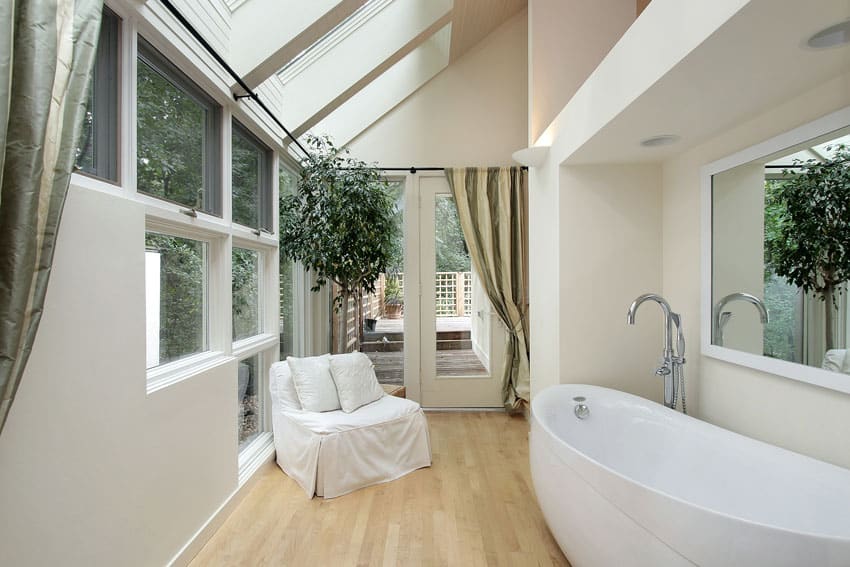
Wood might not sound like the standard choice for a bathroom. After all, it isn’t often considered usable in areas that are expected to be wet frequently. Well, the truth is, it depends on what type of wood flooring you are using. A smart alternative to using real wood flooring in the bathroom is opting for a wood-look porcelain tile floor.
While bare wood isn’t a good idea for your bathroom, engineered wood might be an acceptable alternative. The plywood base of engineered wood flooring makes it well-suited to moisture.
The top layer is wood and looks like any other hardwood floor. This flooring material comes in different colors and designs. It’s the best choice if you wish to have natural wood in your bathroom.
That being said, engineered wood is still wood. It will stand up to moisture better than standard wood, but it still will not handle moisture as well as a material like porcelain. Moisture can cause wood to warp and expand. To prevent this, you’ll want to seal the floor properly and use an adhesive between planks to prevent water from seeping through the cracks.
A good thing is that wood won’t be as cold to step on in the middle of the night or first thing in the morning as tiles would.
An alternative to wood products is to use an LVT or luxury vinyl tile that looks like wood. LVT holds up to moisture quite well and is very durable. Also consider a porcelain wood-look tile product that also can handle wet conditions such as a bathroom design.
Metal Tile
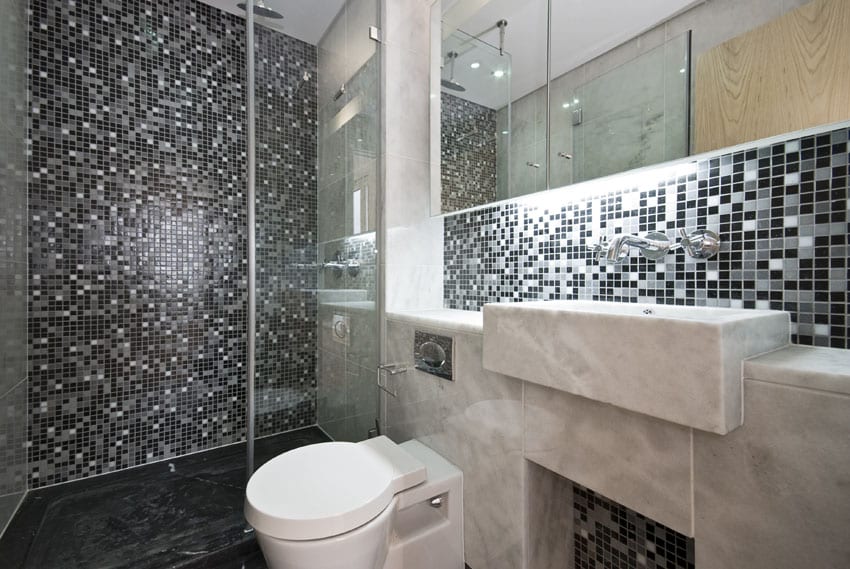
Metal tiles aren’t as popular for bathroom floors as for bathroom walls. However, they are a great way to add a modern touch to your home. You should also know that metal doesn’t have just one industrial appearance. You can find stainless steel, metallic steel, and even glass-hued steel.
Metal tiles also come in a variety of styles. While you can get plain, smooth tiles, many use imprinted patterns to bring texture to a bathroom. These could be simple geometric shapes or more detailed and artistic imagery. The latter is often chosen when metal is used in a backsplash or wall. Highly decorated metal tiles are mostly used alongside other types.
Metal does do well with water, but it will get cold under bare feet. It can also be slippery when wet, but more textured designs can work better at helping to prevent slips and falls.
Pebble Tile
Pebble tiles also go by the name river rock. As the name suggests, these make your floor look covered in small rocks or pebbles. This is a fantastic choice for homeowners who want a natural appearance from their floor. Thanks to their shape and texture, these pebble tiles lend themselves to an organic appearance even more than natural stone.
The name of the river rock pebble tile is accurate and descriptive. Just like pebbles you see outside, getting water on your floor will not stain or ruin them. Pebble tiles aren’t a frequently used option, so they’ll give your bathroom a truly distinct look. It should be noted that these floors are uneven.
So, while not a set-in-stone drawback, some homeowners may not appreciate the feeling of pebbles on bare feet. This is usually minimized when the pebbles are used closer together or flatter. One drawback that is set in stone is the aspect of keeping this type of flooring clean. The elevation changes and sometimes tight nooks and crannies between stones can make it hard to sweep or mop pebble tile flooring.
Best Tiles for Bathroom Floor and Walls
The best tiles for your bathroom floor and walls depend on several factors, including personal preference. For instance, what’s your price range? What features are you looking for? What appearance do you want the floor to have? The perfect material for one person might not be what you want.
While these questions must be answered personally, we can examine some of the most popular bathroom choices. By a landslide, the most popular materials are porcelain and ceramic tiles. This makes a lot of sense as these are affordable options. They are also durable and have an incredibly low water absorption rate, making them an effective choice for bathrooms.
After these materials, more highly decorative options start to crop up. Behind ceramic, the next three most popular are marble, mosaic tile, and limestone. These materials are considered some of the more attractive options for a bathroom floor. Marble and limestone have countless naturally occurring designs. Mosaic tiles are also popular for their looks and are less expensive than solid natural stone.
Best Tiles for Small Bathroom Floor
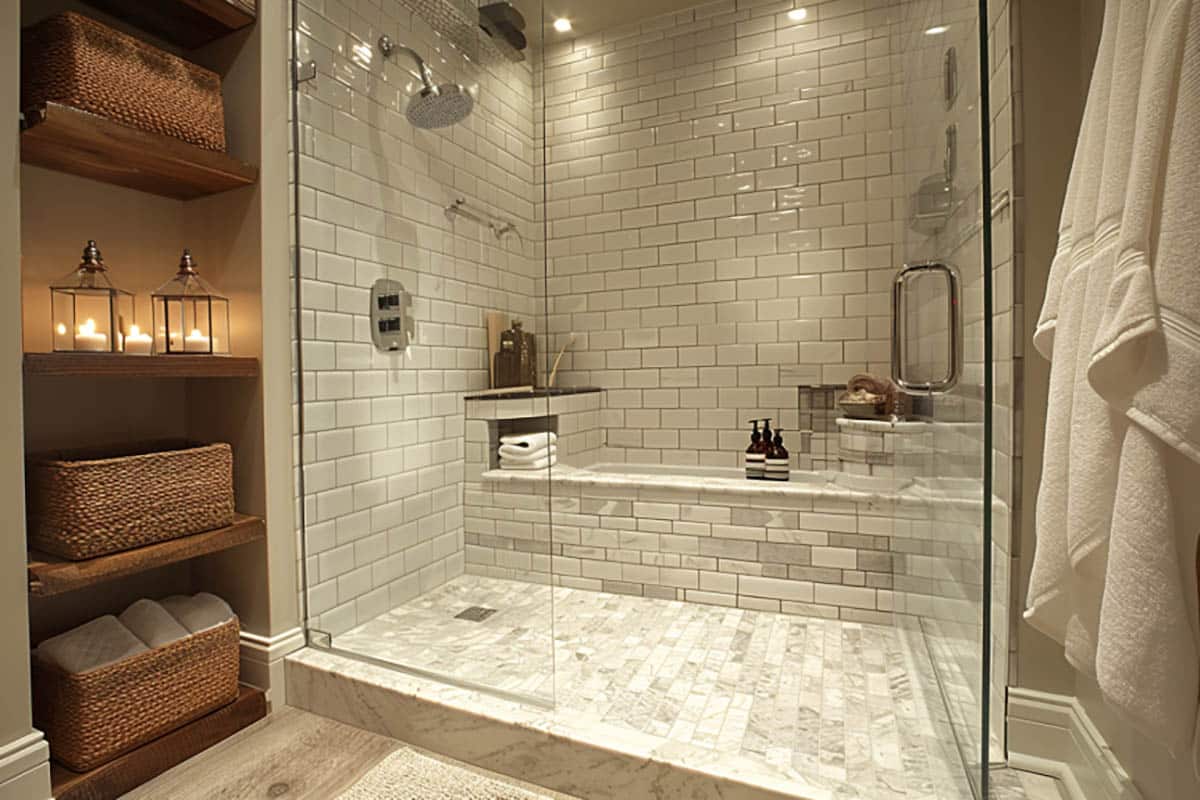
When designing a smaller room, you want to make the right choices to make the most of the space. To do this, you’ll need to think purposefully. White tiles work well in a small space because they give the room a bright, more welcoming atmosphere. Large tiles can also help create the illusion of more space.
You’ll also want to consider tile patterns. Simply putting one ceramic square next to another isn’t likely to be the best use of the space. Instead, for example, hexagonal tiles in a herringbone pattern can be used to make the bathroom look bigger. If you want to use large square tiles, try natural stone with an interesting pattern. Chevron stripe tiles are also a beneficial choice when trying to maximize the space and create the appearance of a larger room.
You can also add a more spacious aesthetic using the tiles on your shower floor. This type of seamless and uniform design makes the bathroom seem more expansive.
If you are considering redoing your floors, several bathroom remodel software programs can help. One of these programs can help you create a design using your room’s layout and add your own finishes, tile, and flooring to get the results you desire.

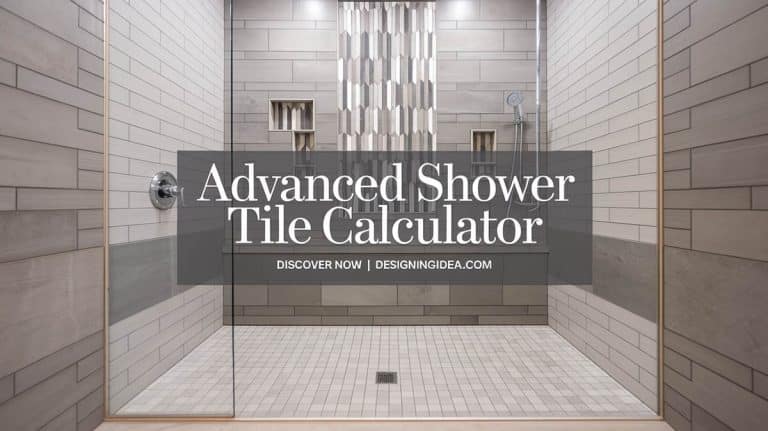
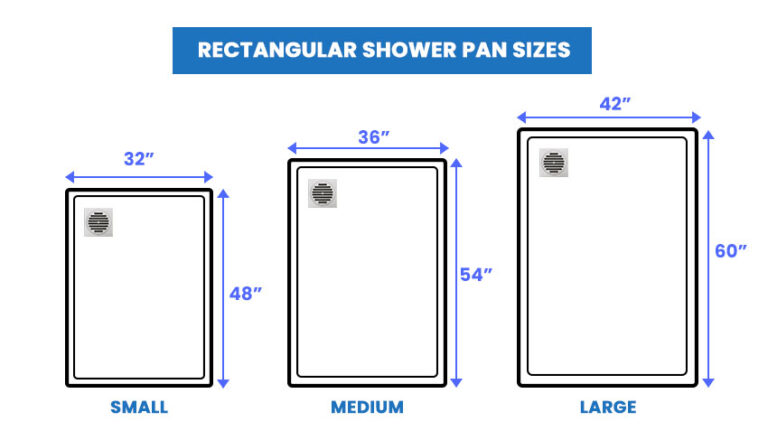
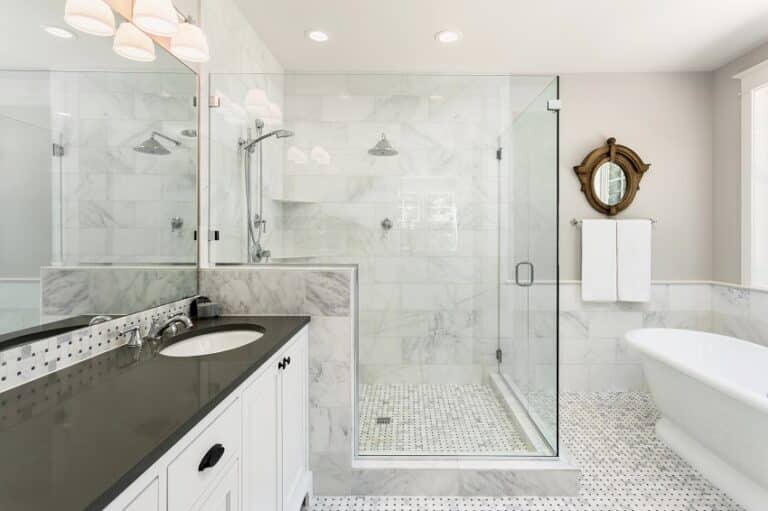
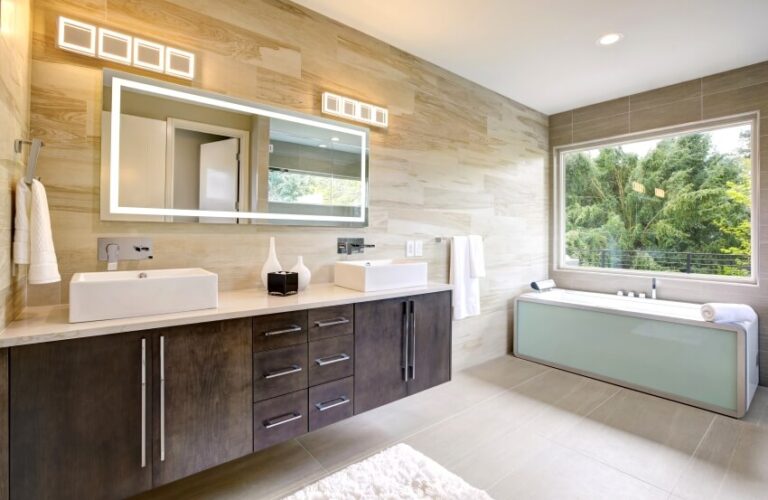

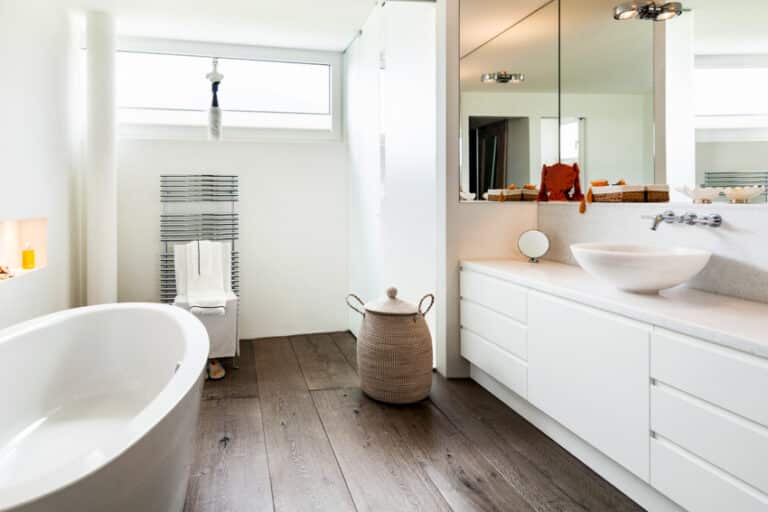
I love the look of the black river rock pebble tile against the granite shower tiles. it’s such a nice contrast. my daughter is moving back home for the next few years and we are hoping to surprise her with a bathroom remodel to help her feel more grown-up while living at home. We would love to find a tile specialist who can help us recreate this look and give our daughter the perfect bathroom.